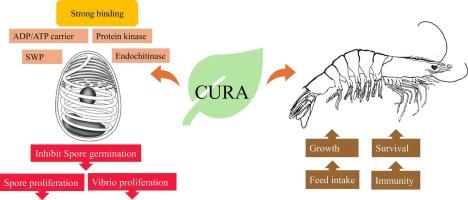“CIBA EHP Cura I”对对虾养殖中肝外核孢子虫的防治效果
IF 3.9
1区 农林科学
Q1 FISHERIES
引用次数: 0
摘要
肝原胞核孢子虫(EHP)是一种真核微孢子虫寄生虫,在许多养虾国家造成巨大的经济损失。然而,对EHP管理有效的预防和治疗方法非常有限。本研究发现了一种以植物为基础的治疗EHP的有效药物,并将其命名为“CIBA EHP Cura I”(Cura)。甲硝唑(Met)、替硝唑(Tin)、阿苯达唑(Alb)、硝苯地平(Nif)、酮康唑(Ket)、维拉帕米(Ver)等药物以及植物衍生物如香芹酚(Car)和Cura等药物对EHP进行了评估。虽然所有药物均显著降低EHP负荷,但除Cura外,它们引起虾肝胰脏严重坏死、变性和黑色变色。而用Cura喂养的虾显示肝胰腺基本正常,没有任何退行性变化。此外,除Cura外,其他所有药物基本上都不能促进虾的生长和存活。在0.1%的浓度下,Cura能完全抑制EHP孢子的体外萌发。在进一步的试验中,对ehp攻毒对虾(n = 25,每3个重复)投喂在饲料上涂有Cura(0.05%、0.1%、0.15%和0.2%)的饲料,饲养60 d。添加0.1%、0.15%和0.2%库拉酸的对虾先天免疫活性(过氧化氢酶、酚氧化酶和总血细胞计数)显著提高,增重和存活率显著提高。0.15%的Cura在所有处理中表现出更高的性能。Cura与硅酸EHP的SWP、ADP/ATP载体、蛋白激酶和几丁质内源性酶等多个靶点具有较强的结合亲和力。此外,Cura对副溶血性弧菌具有很强的抗菌活性。因此,本研究强调Cura作为一种有前景的基于植物的治疗方法,可以有效地治疗EHP。本文章由计算机程序翻译,如有差异,请以英文原文为准。

Efficacy of ‘CIBA EHP Cura I' in the control and treatment of Ecytonucleospora hepatopenaei in shrimp culture
Ecytonucleospora hepatopenaei (EHP), a eukaryotic microsporidian parasite, causes huge economic losses in many shrimp-farming nations. However, effective prophylactics and therapeutics for EHP management are very limited. In this study, a phytobiotic-based therapeutic was found to be effective in controlling EHP and was named ‘CIBA EHP Cura I' (Cura). Drugs such as metronidazole (Met), tinidazole (Tin), albendazole (Alb), nifedipine (Nif), ketoconazole (Ket), verapamil (Ver), and plant derivatives such as carvacrol (Car) along with Cura were evaluated against EHP. Though all the drugs significantly reduced EHP load, they cause severe necrosis, degeneration and black discolouration in shrimp hepatopancreas except for Cura. While, the shrimp fed with Cura showed a largely normal hepatopancreas without any degenerative changes. Also, all the other drugs except Cura largely failed to increase the growth and survival of shrimp. At 0.1 %, the Cura was found to completely inhibit the EHP spore germination in vitro. In further experiments, the EHP-challenged shrimp (n = 25 in triplicate) were fed with feed top coated with Cura (0.05 %, 0.1 %, 0.15 % and 0.2 %) and reared for 60 days. The shrimp group fed with Cura at 0.1 %, 0.15 % and 0.2 % exhibited significantly higher innate immune activity (catalase, phenol oxidase and total haemocyte count) and significantly higher weight gain and survival rate. Cura, at 0.15 %, exhibited higher performance across all the treatments. Cura showed strong binding affinity with multiple targets such as SWP, ADP/ATP carrier, protein kinase, and endochitinase of EHP in silico. Additionally, Cura demonstrated potent antibacterial activity against Vibrio parahaemolyticus. Thus, this study highlights Cura, as a promising phytobiotic-based therapeutic for the effective EHP management.
求助全文
通过发布文献求助,成功后即可免费获取论文全文。
去求助
来源期刊

Aquaculture
农林科学-海洋与淡水生物学
CiteScore
8.60
自引率
17.80%
发文量
1246
审稿时长
56 days
期刊介绍:
Aquaculture is an international journal for the exploration, improvement and management of all freshwater and marine food resources. It publishes novel and innovative research of world-wide interest on farming of aquatic organisms, which includes finfish, mollusks, crustaceans and aquatic plants for human consumption. Research on ornamentals is not a focus of the Journal. Aquaculture only publishes papers with a clear relevance to improving aquaculture practices or a potential application.
 求助内容:
求助内容: 应助结果提醒方式:
应助结果提醒方式:


